|
|
|
Sort Order |
|
|
|
Items / Page
|
|
|
|
|
|
|
| Srl | Item |
| 1 |
ID:
110803
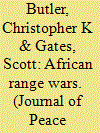

|
|
|
|
|
| Publication |
2012.
|
| Summary/Abstract |
This article examines the effect of climate change on a type of armed conflict that pits pastoralists (cattle herders) against each other (range wars). Such conflicts are typically fought over water rights and/or grazing rights to unfenced/unowned land. The state is rarely involved directly. The rangeland of East Africa is a region particularly vulnerable to drought and livestock diseases associated with climate change. To analyze the possible effects of climate change on pastoral conflict, we focus our analysis on changes in resource availability, contrasting cases of abundance and scarcity. The role of resources is further contextualized by competing notions of property rights, and the role of the state in defining property and associated rights. We employ a contest success function (CSF) game-theoretic model to analyze the logic of range wars. This CSF approach emphasizes the low-level, non-binary nature of raiding behavior between pastoralist groups over limited natural resources. A central contribution of this approach is that the logic of raiding behavior implies a positive relationship between resources and conflict. This positive relationship is supported by several studies of the rangeland of East Africa, but is generally dismissed by the literature on the 'resource curse'. This relationship is contingent on other factors examined in the model, producing the following results. First, the level of property rights protection provided by the state generally reduces conflict between pastoralist groups. Second, if property rights protection is provided in a biased manner, then conflict between pastoralist groups increases. Third, severe resource asymmetries between two pastoralist groups will induce the poorer group to become bandits (focusing their efforts on raiding and not producing), while the richer group raids in retaliation.
|
|
|
|
|
|
|
|
|
|
|
|
|
|
|
|
| 2 |
ID:
110810


|
|
|
|
|
| Publication |
2012.
|
| Summary/Abstract |
This article presents a model of development, civil war and climate change. There are multiple interactions. Economic growth reduces the probability of civil war and the vulnerability to climate change. Climate change increases the probability of civil war. The impacts of climate change, civil war and civil war in the neighbouring countries reduce economic growth. The model has two potential poverty traps - one is climate-change-induced and one is civil-war-induced - and the two poverty traps may reinforce one another. The model is calibrated to sub-Saharan Africa and a double Monte Carlo analysis is conducted in order to account for both parameter uncertainty and stochasticity. Although the IPCC Special Report on Emission Scenarios (SRES) is used as the baseline, thus assuming rapid economic growth in Africa and convergence of African living standards to the rest of the world, the impacts of civil war and climate change (ignored in SRES) are sufficiently strong to keep a number of countries in Africa in deep poverty with a high probability.
|
|
|
|
|
|
|
|
|
|
|
|
|
|
|
|
| 3 |
ID:
110816
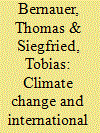

|
|
|
|
|
| Publication |
2012.
|
| Summary/Abstract |
We engage in a critical assessment of the neo-malthusian claim that climatic changes can be an important source of international tensions, in the extreme even militarized interstate disputes. The most likely scenario is conflict over water allocation in international catchments shared by poorer, less democratic, and politically less stable countries, governed by weak international water management institutions, and exposed to severe climatic changes. The Syr Darya corresponds quite well to all these characteristics. If the neo-malthusian specter of conflict over water is empirically relevant, we should see signs of this in the Syr Darya. The riparian countries of the Aral Sea basin have experienced international disputes over water allocation ever since the USSR collapsed and, with it, existing water management institutions and funding. The worst such dispute concerns the Syr Darya, one of the two largest rivers in Central Asia. Based on hydrological data and other information we find that the only existing international water management institution in the Syr Darya has failed. Based on a coupled climate, land-ice and rainfall-runoff model for the Syr Darya, we then examine whether, in the absence of an effective international water allocation mechanism, climate change is likely to make existing international tensions over water allocation worse. We find that climate change-induced shifts in river runoff, to which the Uzbek part of the Syr Darya catchment is particularly vulnerable, and which could contribute to a deterioration of already strained Kyrgyz-Uzbek relations, are likely to set in only in the medium to long term. This leaves some time for the riparian countries to set up an effective international framework for water allocation and prevention of climate-induced geohazards. By implication, our findings suggest that a climate change-induced militarized interstate dispute over water resources in Central Asia is unlikely.
|
|
|
|
|
|
|
|
|
|
|
|
|
|
|
|
| 4 |
ID:
110817


|
|
|
|
|
| Publication |
2012.
|
| Summary/Abstract |
The Middle East is among the least stable and most fragile regions. It is not surprising, therefore, that concerns have been raised regarding the potential implications of climate change. This article critically examines the potential interactions between climate change and conflict in the Israeli-Palestinian case. Based on a review of the possible effects of climate change, water is identified as the main issue which may be affected, and it also has transboundary implications. We illustrate the potential implications of reduced freshwater availability by assessing the ability to supply normative domestic water needs under rapid population growth scenarios, including return of refugees. In addition, the ability to supply environmental needs and the needs of peripheral farmers under extremely reduced availability scenarios is examined. The normative domestic demand in Israel and the West Bank can be supplied on the basis of natural resources, though re-allocation of water from Israel to the Palestinians is necessary. The Gaza Strip cannot supply the normative domestic needs under any scenario and hence requires immediate augmentation, regardless of climate change. Desalination can supply Gaza's needs and augment water resources in Israel and the West Bank, thereby partially decoupling domestic and agricultural use from climate. Thus, it is unlikely that climate change will directly affect the conflict. However, framing water as a security issue, along with the potential for furthering such securitization with reference to climate change, may adversely affect the readiness of the parties to take adaptive measures and lead them to rigidify their negotiating positions. Possible effects of climate change on other regional players, particularly Egypt and Jordan, may have indirect effects on the Israeli-Palestinian scene. But this hypothesis requires further study.
|
|
|
|
|
|
|
|
|
|
|
|
|
|
|
|
| 5 |
ID:
110814


|
|
|
|
|
| Publication |
2012.
|
| Summary/Abstract |
In the existing 276 international river basins, the increase in water variability projected by most climate change scenarios may present serious challenges to riparian states. This research maps the institutional resilience to water variability in transboundary basins and combines it with both historic and projected variability regimes, with the objective of identifying areas at potential risk of future hydropolitical tension. To do so, it combs existing international treaties for sources of institutional resilience and considers the coefficient of variation of runoff as a measure of past and future water variability. The study finds significant gaps in both the number of people and area covered by institutional stipulations to deal with variability in South America and Asia. At present, high potential risk for hydropolitical tensions associated with water variability is identified in 24 transboundary basins and seems to be concentrated mainly in northern and sub-Saharan Africa. By 2050, areas at greatest potential risk are more spatially dispersed and can be found in 61 international basins, and some of the potentially large impacts of climate change are projected to occur away from those areas currently under scrutiny. Understanding when and where to target capacity-building in transboundary river basins for greater resilience to change is critical. This study represents a step toward facilitating these efforts and informing further qualitative and quantitative research into the relationship between climate change, hydrological variability regimes, and institutional capacity for accommodating variability.
|
|
|
|
|
|
|
|
|
|
|
|
|
|
|
|
| 6 |
ID:
110804
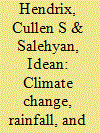

|
|
|
|
|
| Publication |
2012.
|
| Summary/Abstract |
Much of the debate over the security implications of climate change revolves around whether changing weather patterns will lead to future conflict. This article addresses whether deviations from normal rainfall patterns affect the propensity for individuals and groups to engage in disruptive activities such as demonstrations, riots, strikes, communal conflict, and anti-government violence. In contrast to much of the environmental security literature, it uses a much broader definition of conflict that includes, but is not limited to, organized rebellion. Using a new database of over 6,000 instances of social conflict over 20 years - the Social Conflict in Africa Database (SCAD) - it examines the effect of deviations from normal rainfall patterns on various types of conflict. The results indicate that rainfall variability has a significant effect on both large-scale and smaller-scale instances of political conflict. Rainfall correlates with civil war and insurgency, although wetter years are more likely to suffer from violent events. Extreme deviations in rainfall - particularly dry and wet years - are associated positively with all types of political conflict, though the relationship is strongest with respect to violent events, which are more responsive to abundant than scarce rainfall. By looking at a broader spectrum of social conflict, rather than limiting the analysis to civil war, we demonstrate a robust relationship between environmental shocks and unrest.
|
|
|
|
|
|
|
|
|
|
|
|
|
|
|
|
| 7 |
ID:
110806
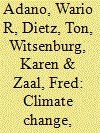

|
|
|
|
|
| Publication |
2012.
|
| Summary/Abstract |
Many regions that are endowed with scarce natural resources such as arable land and water, and which are remote from a central government, suffer from violence and ethnic strife. A number of studies have looked at the convergence of economic, political and ecological marginality in several African countries. However, there is limited empirical study on the role of violence in pastoral livelihoods across ecological and geographical locations. Yet, case studies focusing on livelihood and poverty issues could inform us about violent behaviour as collective action or as individual decisions, and to what extent such decisions are informed or explained by specific climatic conditions. Several case studies point out that violence is indeed an enacted behaviour, rooted in culture and an accepted form of interaction. This article critically discusses the relevance of geographical and climatic parameters in explaining the connection between poverty and violent conflicts in Kenya's pastoral areas. These issues are considered vis-à-vis the role institutional arrangements play in preventing violent conflict over natural resources from occurring or getting out of hand. The article uses long-term historical data, archival information and a number of fieldwork sources. The results indicate that the context of violence does not deny its agency in explanation of conflicts, but the institutional set-up may ultimately explain the occurrence of the resource curse.
|
|
|
|
|
|
|
|
|
|
|
|
|
|
|
|
| 8 |
ID:
110807
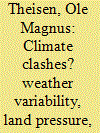

|
|
|
|
|
| Publication |
2012.
|
| Summary/Abstract |
The evidence of coming climate change has generated catastrophe-like statements of a future where a warmer, wetter, and wilder climate leads to a surge in migrant streams and gives rise to new wars. Although highly popular in policy circles, few of these claims are based on systematic evidence. Using a most-likely case design on Kenya 1989-2004, with new geographically disaggregated data on armed conflicts below the common civil conflict level, this study finds that climatic factors do influence the risk of conflicts and violent events. The effect is opposite to what should be expected from much of the international relations literature; rather, it supports the observations made by recent anthropological studies. Years with below average rainfall tend to have a peaceful effect on the following year and less robustly so for the current year as well. Little support is found for the notion that scarcity of farmland fuels violence in itself or in election years. More densely populated areas - not areas with a low land per capita ratio - run a higher risk of conflict. Election years systematically see more violence, however. The findings therefore support the notion that large-scale intergroup violence is driven by calculation and political gain rather than desperate scrambles for scarce land, pasture, and water resources.
|
|
|
|
|
|
|
|
|
|
|
|
|
|
|
|
| 9 |
ID:
110809


|
|
|
|
|
| Publication |
2012.
|
| Summary/Abstract |
Despite many claims by high-ranking policymakers and some scientists that climate change breeds violent conflict, the existing empirical literature has so far not been able to identify a systematic, causal relationship of this kind. This may either reflect de facto absence of such a relationship, or it may be the consequence of theoretical and methodological limitations of existing work. In this article we revisit the climate-conflict hypothesis along two lines. First, we concentrate on indirect effects of climatic conditions on conflict, whereas most of the existing literature focuses on direct effects. Specifically, we examine the causal pathway linking climatic conditions to economic growth and to armed conflict, and argue that the growth-conflict part of this pathway is contingent on the political system. Second, we employ a measure of climatic variability that has advantages over those used in the existing literature because it can presumably take into account the adaptation of production to persistent climatic changes. For the empirical analysis we use a global dataset for 1980-2004 and design the testing strategy tightly in line with our theory. Our empirical analysis does not produce evidence for the claim that climate variability affects economic growth. However, we find some, albeit weak, support for the hypothesis that non-democratic countries are more likely to experience civil conflict when economic conditions deteriorate.
|
|
|
|
|
|
|
|
|
|
|
|
|
|
|
|
| 10 |
ID:
110811


|
|
|
|
|
| Publication |
2012.
|
| Summary/Abstract |
Global warming is expected to make the climate warmer, wetter, and wilder. It is predicted that such climate change will increase the severity and frequency of climate-related disasters like flash floods, surges, cyclones, and severe storms. This article uses econometric methods to study the consequences of climate-induced natural disasters on economic growth, and how these disasters are linked to the onset of armed civil conflict either directly or via their impact on economic growth. The results show that climate-related natural disasters have a negative effect on growth and that the impact is considerable. The analysis of conflict onset shows that climate-related natural disasters do not increase the risk of armed conflict. This is also true when we instrument the change in GDP growth by climatic disasters. The result is robust to inclusion of country and time fixed effects, different estimation techniques, and various operationalization of the disasters measure, as well as for conflict incidence and war onset. These findings have two major implications: if climate change increases the frequency or makes weather-related natural disasters more severe, it is an economic concern for countries susceptible to these types of hazards. However, our results suggest - based on historical data - that more frequent and severe climate-related disasters will not lead to more armed conflicts through their effects on GDP growth.
|
|
|
|
|
|
|
|
|
|
|
|
|
|
|
|
| 11 |
ID:
110805
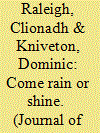

|
|
|
|
|
| Publication |
2012.
|
| Summary/Abstract |
Previous research on environment and security has contested the existence, nature and significance of a climate driver of conflict. In this study, we have focused on small-scale conflict over East Africa where the link between resource availability and conflict is assumed to be more immediate and direct. Using the parameter of rainfall variability to explore the marginal influence of the climate on conflict, the article shows that in locations that experience rebel or communal conflict events, the frequency of these events increases in periods of extreme rainfall variation, irrespective of the sign of the rainfall change. Further, these results lend support to both a 'zero-sum' narrative, where conflicting groups use force and violence to compete for ever-scarcer resources, and an 'abundance' narrative, where resources spur rent-seeking/wealth-seeking and recruitment of people to participate in violence. Within the context of current uncertainty regarding the future direction of rainfall change over much of Africa, these results imply that small-scale conflict is likely to be exacerbated with increases in rainfall variability if the mean climate remains largely unchanged; preferentially higher rates of rebel conflict will be exhibited in anomalously dry conditions, while higher rates of communal conflict are expected in increasingly anomalous wet conditions.
|
|
|
|
|
|
|
|
|
|
|
|
|
|
|
|
| 12 |
ID:
110813


|
|
|
|
|
| Publication |
2012.
|
| Summary/Abstract |
Growing interest in the social consequences of climate change has fueled speculation that global warming could lead to an increase in various forms of political violence. This article examines the effects of climate change on international conflict subsequent to the onset of European industrialization. Surprisingly, analysis at the system level suggests that global warming is associated with a reduction in interstate conflict. This naive relationship is suspect, however, as the increased consumption of carbon-based fuels is itself associated with changing patterns of politics and prosperity. In particular, economic development has been viewed as a cause of both climate change and interstate peace. Incorporating measures of development, democracy, cross-border trade, and international institutions reveals that systemic trends toward peace are actually best accounted for by the increase in average international income. The results imply that climate change, which poses a number of critical challenges for citizens and policymakers, need not be characterized as fundamentally a security issue, though climate change may have important security implications on the periphery of world politics. The analysis here also suggests that efforts to curb climate change should pay particular attention to encouraging clean development among middle-income states, as these countries are the most conflict prone. Ironically, stagnating economic development in middle-income states caused by efforts to combat climate change could actually realize fears of climate-induced warfare.
|
|
|
|
|
|
|
|
|
|
|
|
|
|
|
|
| 13 |
ID:
110808


|
|
|
|
|
| Publication |
2012.
|
| Summary/Abstract |
While climate change scenarios for the Sahel vary and are uncertain, the most popularized prediction says there will progressively be drier conditions with more erratic rainfall. According to some, an increase in violent conflicts over scarce resources should also be expected. This article investigates the climate-conflict nexus in detail, focusing on a distinct area at the heart of the Sahel, the inland delta of the Niger river in the Mopti region of Mali. Two complementary analytical approaches are applied. The first consists of collection and analysis of court data on land-use conflicts, 1992-2009, from the regional Court of Appeal in Mopti. A comparison of the conflict data with statistics on contemporaneous climatic conditions gives little substance to claims that climate variability is an important driver of these conflicts. Second, we carried out a qualitative analysis of one of the many land-use conflicts in the region. Again, we find that factors other than those directly related to environmental conditions and resource scarcity dominate as plausible explanations of the violent conflict. We argue that three structural factors are the main drivers behind these conflicts: agricultural encroachment that obstructed the mobility of herders and livestock, opportunistic behavior of rural actors as a consequence of an increasing political vacuum, and corruption and rent seeking among government officials.
|
|
|
|
|
|
|
|
|
|
|
|
|
|
|
|
| 14 |
ID:
110812
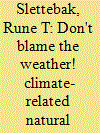

|
|
|
|
|
| Publication |
2012.
|
| Summary/Abstract |
The issue of climate change and security has received much attention in recent years. Still, the results from research on this topic are mixed and the academic community appears to be far from a consensus on how climate change is likely to affect stability and conflict risk in affected countries. This study focuses on how climate-related natural disasters such as storms, floods, and droughts have affected the risk of civil war in the past. The frequency of such disasters has risen sharply over the last decades, and the increase is expected to continue due to both climate change and demographic changes. Using multivariate methods, this study employs a global sample covering 1950 to the present in order to test whether adding climate-related natural disasters to a well-specified model on civil conflict can increase its explanatory power. The results indicate that this is the case, but that the relation is opposite to common perceptions: Countries that are affected by climate-related natural disasters face a lower risk of civil war. One worrying facet of the claims that environmental factors cause conflict is that they may contribute to directing attention away from more important conflict-promoting factors, such as poor governance and poverty. There is a serious risk of misguided policy to prevent civil conflict if the assumption that disasters have a significant effect on war is allowed to overshadow more important causes.
|
|
|
|
|
|
|
|
|
|
|
|
|
|
|
|
| 15 |
ID:
110802


|
|
|
|
|
| Publication |
2012.
|
| Summary/Abstract |
This article relies on data from the 2005-09 World Values Survey to examine individual and cross-national variation in perception of the seriousness of global warming. The data show that a large majority of the public in all countries are concerned about the problem of global warming and that this assessment is part of a broader concern for global environmental issues. The widespread concern implies that global warming has the potential to generate mass political participation and demand for political action. Motivated by a value-based approach to the study of public opinion, the article shows that perception of the seriousness of the problem is positively correlated with high education, post-materialism, and a leftist position on the left-right scale. In addition, religious beliefs are important, suggesting that there is some diversity in the value basis for the issue and that it is not only linked to the 'new-politics' perspective. Variation across nations in wealth and CO2 emissions is not significantly related to the publics' assessments of the problem, and, somewhat counterintuitively, people from countries relatively more exposed to climate-related natural disasters are less concerned about global warming. We suggest possible explanations for the latter finding and discuss our results in relation to the broader literature on environmental change, insecurity, and the potential for conflict.
|
|
|
|
|
|
|
|
|
|
|
|
|
|
|
|
| 16 |
ID:
110815
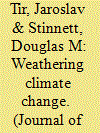

|
|
|
|
|
| Publication |
2012.
|
| Summary/Abstract |
Although the subject remains contested, some have speculated that climate change could jeopardize international security. Climate change is likely to alter the runoff of many rivers due to changes in precipitation patterns. At the same time, climate change will likely increase the demand for river water, due to more frequent droughts and greater stress being placed on other sources of water. The resulting strain on transboundary rivers could contribute to international tensions and increase the risk of military conflict. This study nevertheless notes that the propensity for conflicts over water to escalate depends on whether the river in question is governed by a formal agreement. More specifically, the article argues that the ability of river treaties to adapt to the increase in water stress resulting from climate change will depend on their institutional design. It focuses on four specific institutional features: provisions for joint monitoring, conflict resolution, treaty enforcement, and the delegation of authority to intergovernmental organizations. Treaties that contain more of these features are expected to better manage conflicts caused by water stress. This expectation is tested by analyzing historical data on water availability and the occurrence of militarized conflict between signatories of river treaties, 1950-2000. The empirical results reveal that water scarcity does increase the risk of military conflict, but that this risk is offset by institutionalized agreements. These results provide evidence, albeit indirect, that the presence of international institutions can be an important means of adapting to the security consequences of climate change by playing an intervening role between climate change and international conflict.
|
|
|
|
|
|
|
|
|
|
|
|
|
|
|
|
| 17 |
ID:
110801


|
|
|
|
|
| Publication |
2012.
|
| Summary/Abstract |
Until recently, most writings on the relationship between climate change and security were highly speculative. The IPCC assessment reports to date offer little if any guidance on this issue and occasionally pay excessive attention to questionable sources. The articles published in this special issue form the largest collection of peer-reviewed writings on the topic to date. The number of such studies remains small compared to those that make up the natural science base of the climate issue, and there is some confusion whether it is the effect of 'climate' or 'weather' that is being tested. The results of the studies vary, and firm conclusions cannot always be drawn. Nevertheless, research in this area has made considerable progress. More attention is being paid to the specific causal mechanisms linking climate change to conflict, such as changes in rainfall and temperature, natural disasters, and economic growth. Systematic climate data are used in most of the articles and climate projections in some. Several studies are going beyond state-based conflict to look at possible implications for other kinds of violence, such as intercommunal conflict. Overall, the research reported here offers only limited support for viewing climate change as an important influence on armed conflict. However, framing the climate issue as a security problem could possibly influence the perceptions of the actors and contribute to a self-fulfilling prophecy.
|
|
|
|
|
|
|
|
|
|
|
|
|
|
|
|
|
|
|
|
|